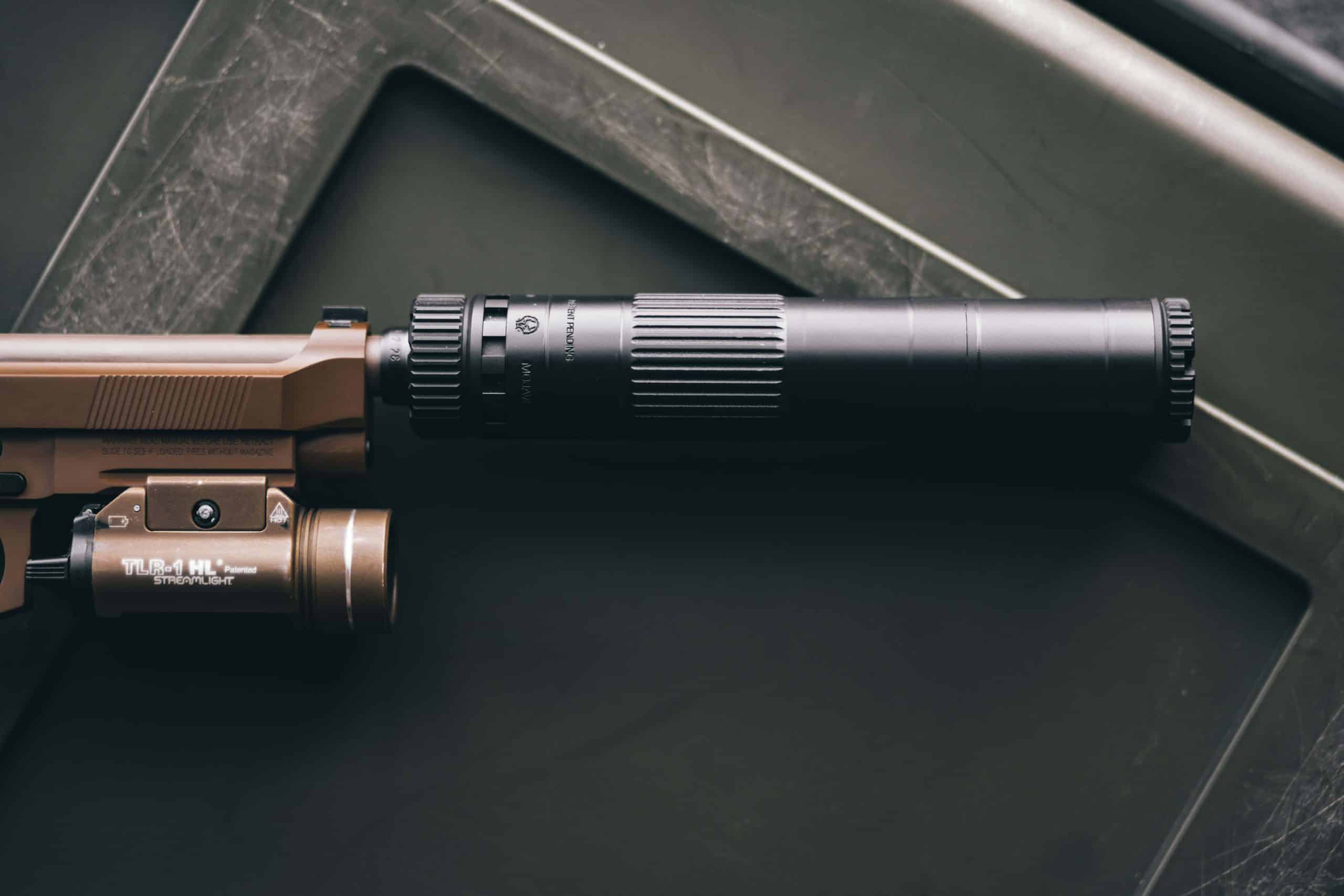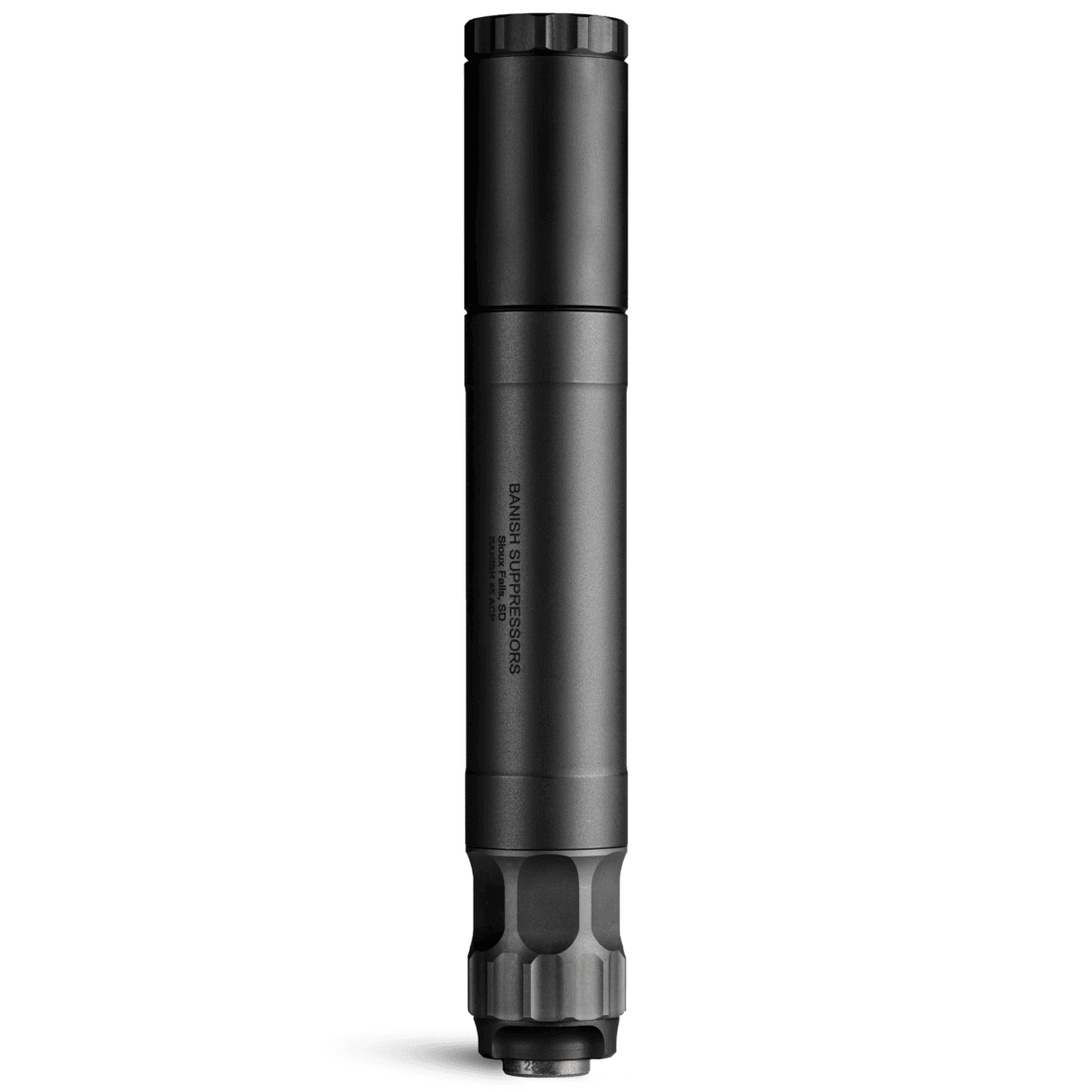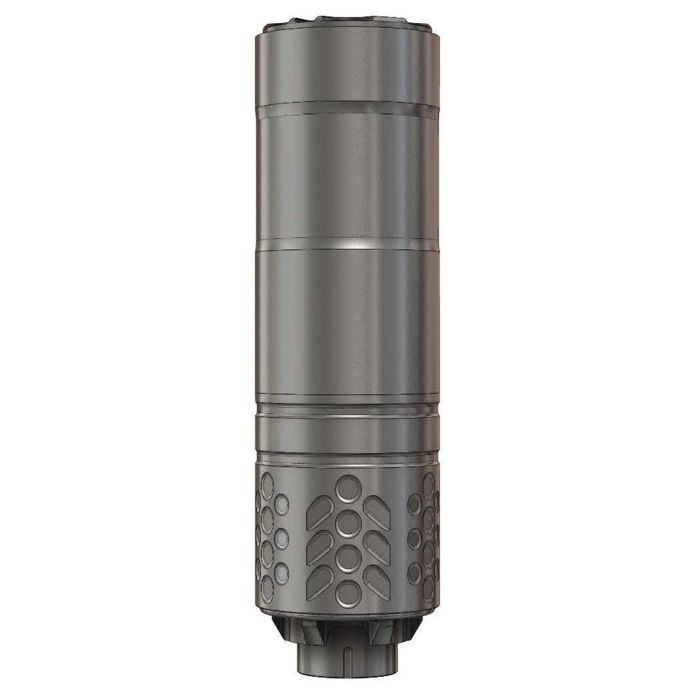7 Best 9MM Suppressors [2025]: Hands-On Tested
Want to turn your 9mm from a barky range toy into something that purrs like a well-fed alley cat?
A good suppressor can make shooting a whole lot more pleasant — less noise, less muzzle flash, and less side-eye from everyone within earshot.
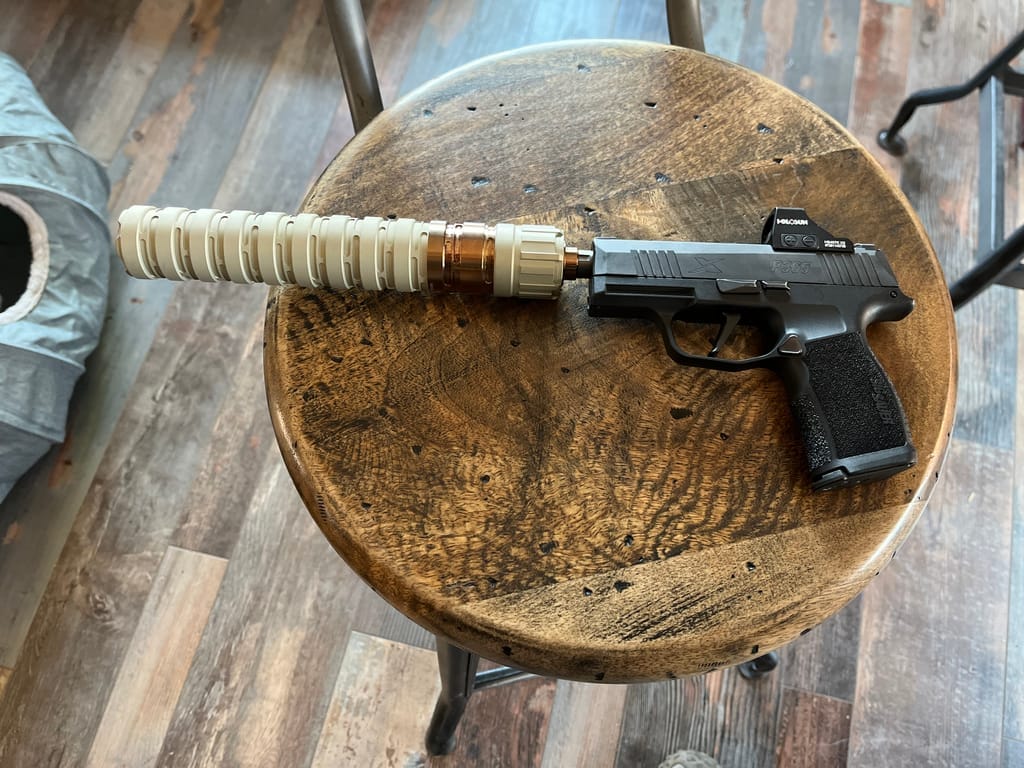
Whether you’re running a pistol, PCC, or subgun, the right can tames recoil, protects your hearing, and keeps you on target during rapid fire. Some even cut down on gas blowback so you’re not breathing in a cloud of your own carbon every time you pull the trigger.
The problem? The suppressor world is a maze. You’ve got direct-thread models, quick-detach systems, user-serviceable cans, multi-caliber setups, and price tags that range from “surprisingly reasonable” to “do I need a second mortgage?” Each comes with its own trade-offs in sound reduction, weight, durability, and maintenance.
How do you choose the best 9mm suppressor for your setup? Which ones are worth the money and which ones will leave you wondering why you went through the wait and paperwork?
We’ve tested the top contenders across the spectrum and broke them down into the best choices for quieting down your 9mm. Whether you’re after the quietest, the toughest, or the best bang for your buck, we’re here to help.
By the end, you’ll have a good idea of the lay of the land when it comes to the best 9mm suppressors.
Let’s hush things up…
1. BEST 9MM SUPPRESSOR OVERALL: Rugged Obsidian 9
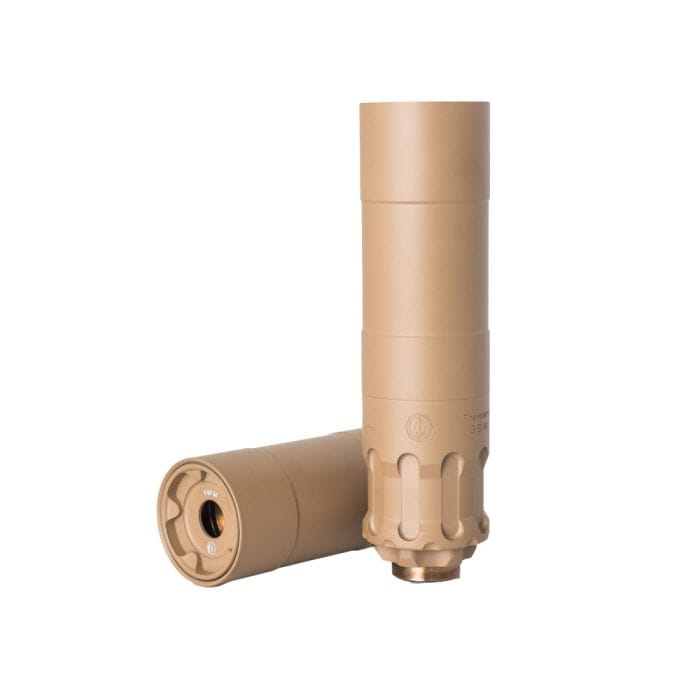
Rugged Obsidian 9
GrabAGun (See Price)
Guns.com (See Price)
Rainier Arms (See Price)
Scheels (See Price)
BattleHawk Armory (See Price)
Euro Optic (See Price)
Classic Firearms (See Price)
If your goal is to suppress a 9mm firearm without overthinking it, the Rugged Obsidian 9 is that suppressor. Rugged has a reputation for building gear that survives hard use, and the Obsidian 9 follows suit.
This do‑it‑all can is modular: run it long when you want maximum hush, or pop the front module off to create a lively K‑length that balances well on a carry pistol. It plays nicely with a wide range of pistons and mounts and handles abuse on PCCs without complaining.
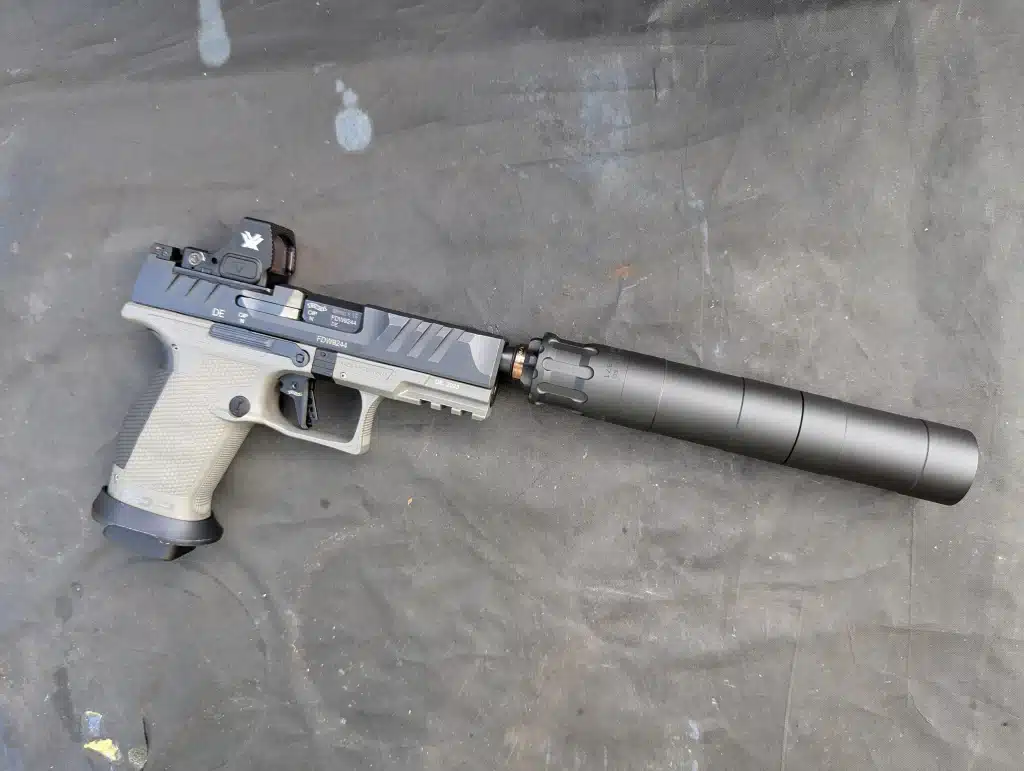
What We Like: There’s a lot that we love about this suppressor.
The ADAPT system gives you two personalities in one tube, a full 7.8” configuration that can be shortened to 4.85”, giving you flexibility between maximum suppression and a compact setup.
Run it long when you want that deep, warm tone on a pistol or PCC. Spin the front module off and it becomes a short, lively K‑length that keeps a carry gun balanced. It plays well with common pistons and mounts, so swapping from a tilt‑barrel handgun to a fixed‑barrel carbine is a parts‑bin job, not a hunt.
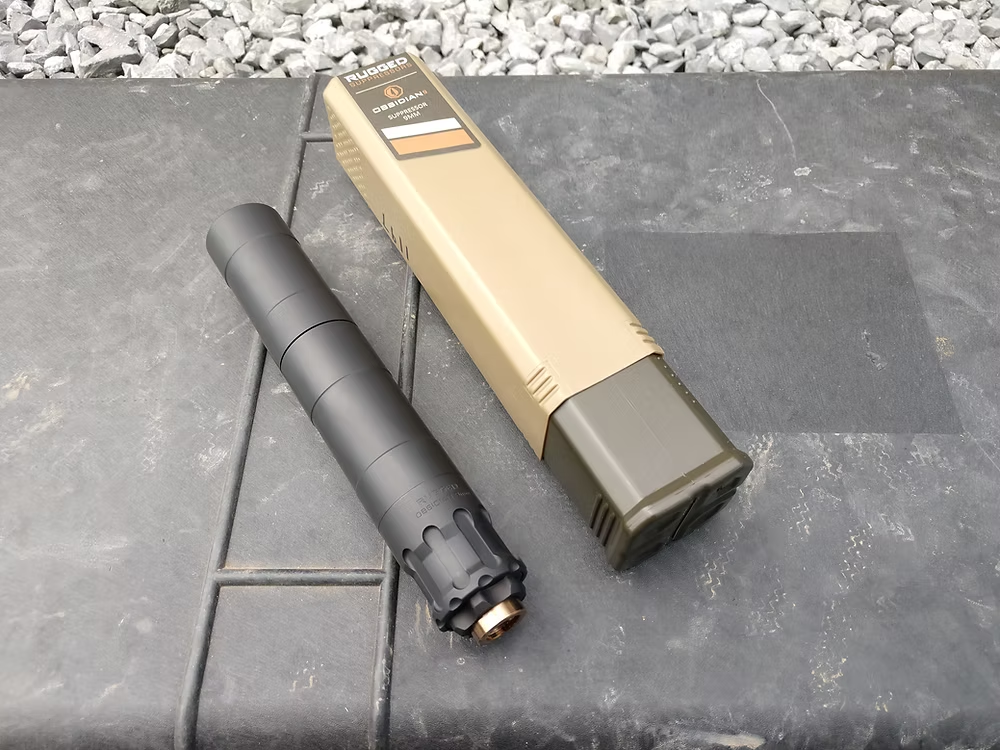
That kind of modularity isn’t rare, but Rugged nails the execution with precision threading that resists carbon build-up issues and a baffle system that reduces blowback.
Its outer tube and modular sections use lightweight aluminum, while the first baffle (AKA Blast Baffle) and core are made from 17-4 stainless steel, offering a strong balance between weight and resilience. It’s rugged (not just the brand name) but not a brick on the end of your barrel. It’s also user-serviceable, which simplifies cleanup after heavy usage.
We also appreciate that Rugged went with an unboosted (no Nielsen device), fixed-barrel-friendly design by default, and includes a piston system to accommodate tilt-barrel handguns. This means it works on a range of hosts out of the box, and you’re not locked into buying accessories. It’s also full-auto rated and supports calibers from 9mm to subsonic .300 Blackout.
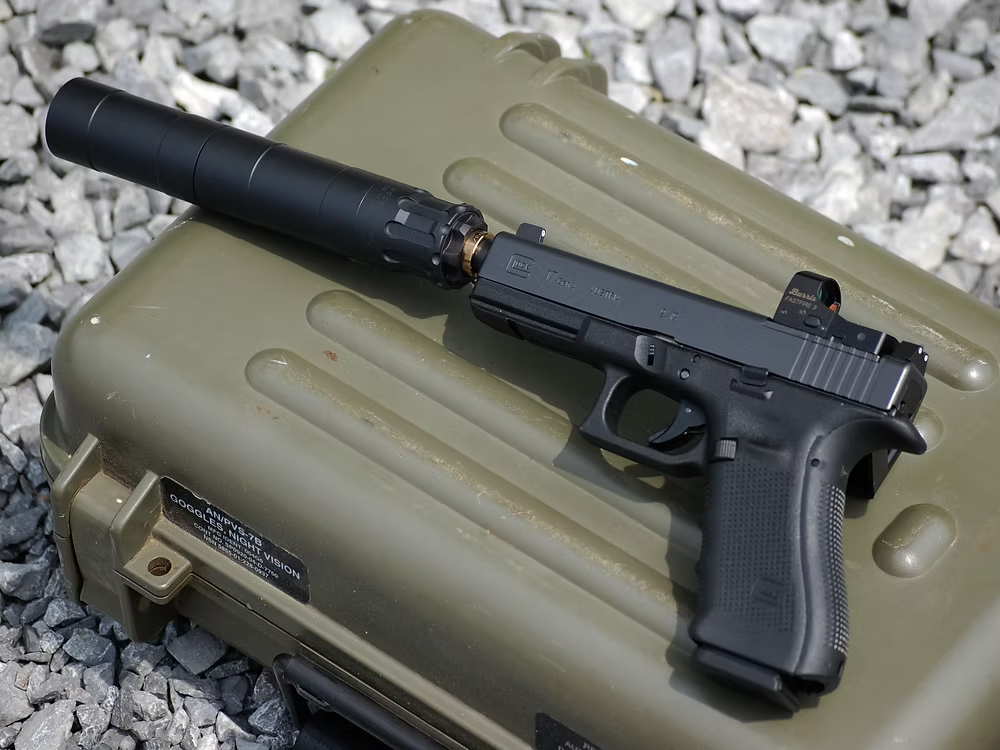
On the range, it sounds consistently smooth and it keeps actions running clean. If you shoot a mix of subsonic 147s and standard pressure loads, you will notice the difference in both report and push.
You might think the Obsidian 9 is one of the pricier entries in this roundup, but all of this suppressory goodness can be yours for between $600 and $700, which is the least expensive except for the YHM R9.
Flaws but Not Dealbreakers: When full-length, the Obsidian 9 is a little long. If you prefer streamlined, then go with the short configuration, though that will sacrifice some suppression performance. As with all the modular suppressors, however, we appreciate having options.
Also, the Obsidian 9 isn’t the lightest suppressor in its class but the tradeoff for durability and modularity is worth it. If you’re sensitive to front-end weight, consider using the short configuration or pairing it with a lighter pistol.
First‑round pop is present in short mode more than long, which is normal for smaller volume. Price sits above bare‑bones cans, but you are essentially getting two setups in one.
Bottom Line: The Rugged Obsidian 9 is for shooters who want one suppressor that does it all right out of the box. Whether you’re running a pistol, a PCC, or even subsonic .300 Blackout, the Obsidian 9 delivers top-tier performance in every category that matters. It’s a modular, tough, fairly priced, and user-serviceable can backed by a company that expects you to put it through its paces. Most people won’t need anything else.
2. RUNNER-UP: Banish 45
Despite the name, the Banish 45 does in fact suppress 9mm ammo. But its name ruins the surprise that it also tames .45 ACP, plus a host of other pistol calibers.
There are suppressors which work with some rifle calibers in addition to 9mm, but for pistol shooters, the wide assortment of pistol calibers supported by the Banish 45 is why its also one of our favorites.
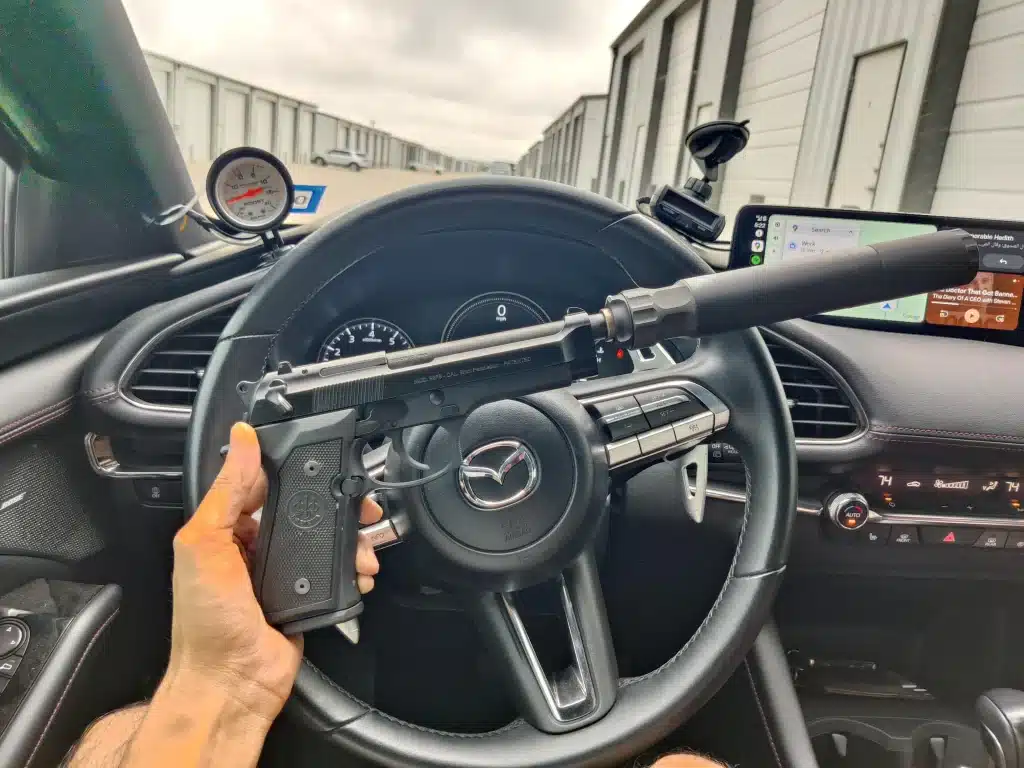
What We Like: Not only does the Banish 45 wrangle .45 ACP but the following pistol calibers as well: .22 LR, .380 ACP, subsonic .300 Blackout, .40 S&W, and 10mm. Unless you’re James Bond with a .32 caliber Walther, you’re covered. I love that I can use it with both my S&W 9mm and HK45 by simply swapping pistons — 1/2×28 for the S&W and .578×28 LH for the HK.
It’s rated for full-auto as are most of the cans on this list, and though full-auto may not be a priority for most pistol shooters, it’s typically an indicator of durability over time.
The Banish 45 is constructed from lightweight titanium, which gives a wonderful balance of strength, weight, and corrosion resistance. Its length can also be easily adjusted from 8.6” down to 6.7”, depending on your use case and suppression needs.
On 9mm with 147‑ or 150‑grain subs, the Banish 45 in long mode gives a deep, low‑frequency tone and keeps first‑round pop tame. On .45 ACP with 230‑grain, expect that satisfying thump more than a crack; action noise becomes the loudest part on most hosts. Short mode trims length and keeps a pistol lively, but you’ll hear a bit more pop on the first shot and a brighter overall tone — fine outdoors, less ideal indoors.
Host swaps are painless if you keep a couple pistons on hand. 1/2×28 covers most American 9mm barrels, .578×28 LH is standard for .45 ACP, and 13.5×1 LH is common on European 9mm guns. Thread changes are quick, and the can doesn’t get picky about brand‑to‑brand barrel variance as long as the shoulder is clean and square.
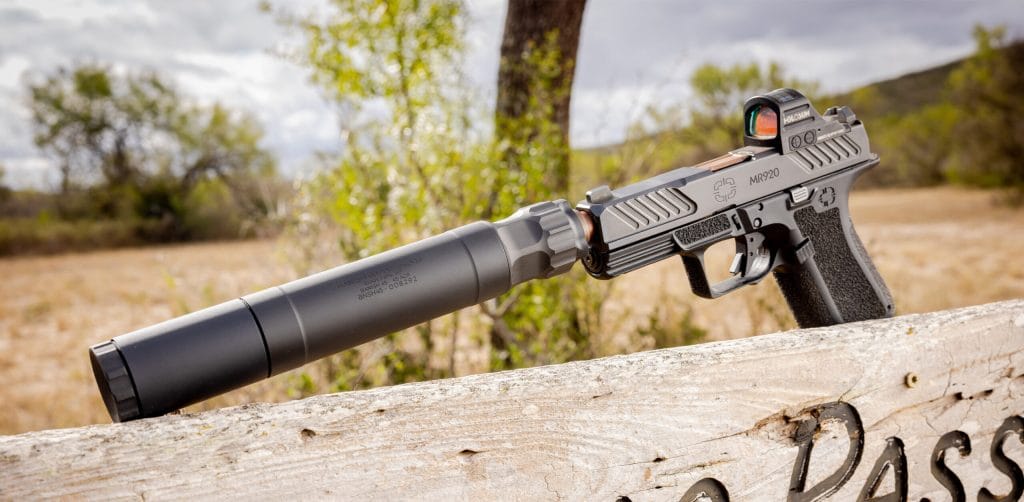
It’s genuinely user‑serviceable. The baffle stack comes out without drama, the tube doesn’t carbon‑weld itself shut, and reassembly is intuitive. A light film of oil on the cap threads and a tiny dab of anti‑seize on the mid‑joint keeps everything friendly after high round counts. If you occasionally dab a drop of silicone grease on the booster O‑ring, the piston runs smooth and doesn’t chew itself up.
PCC use is straightforward with a fixed‑barrel spacer in place of the booster spring. On straight‑blowback carbines, the can’s added backpressure can push a little more soot out of the ejection port during long strings, but the tone stays pleasant and the report drops to the point where action clack and bullet flight are what you hear most.
Flaws But Not Dealbreakers: It’s a multi‑caliber, modular .45 can — that versatility is the selling point, but it won’t be the absolute quietest or shortest on any single caliber. Long mode is the right answer for the best sound; short mode is the right answer for handling. Choose your own adventure.
On compact pistols, long mode can feel nose‑heavy. The short configuration fixes balance but costs you a few decibels and increases first‑round pop. That’s physics, not a Banish problem.
Don’t treat it like a rimfire workhorse just because it can do .22 LR. Lead and powder fouling from rimfire stack up fast in a .45 can. If you shoot a lot of .22, clean promptly and thoroughly, or better yet, keep a dedicated rimfire can.
Modular joints can loosen a touch under heat. Hand‑tighten the mid‑section and end cap before you start, give the can a quick snug check after a couple mags, and you won’t have surprises. Also, make sure you’re using the fixed‑barrel spacer on PCCs; leaving the booster spring in on a fixed barrel is a great way to beat up parts.
Indoors, .45 ACP is still loud even when suppressed. It’s a lower, less punishing tone, but don’t expect movie‑quiet. Ear protection is still smart inside four walls.
Bottom Line: The Banish 45 is what you seek out when you have multiple caliber pistols and want one suppressor that works with all of them. It’s tough, adaptable, and plays well with nearly every handgun you own. In the world of suppressors, this level of pistol caliber versatility is rare, and this one pulls it off.
3. BEST BUDGET-FRIENDLY PICK: Yankee Hill Machine (YHM) R9
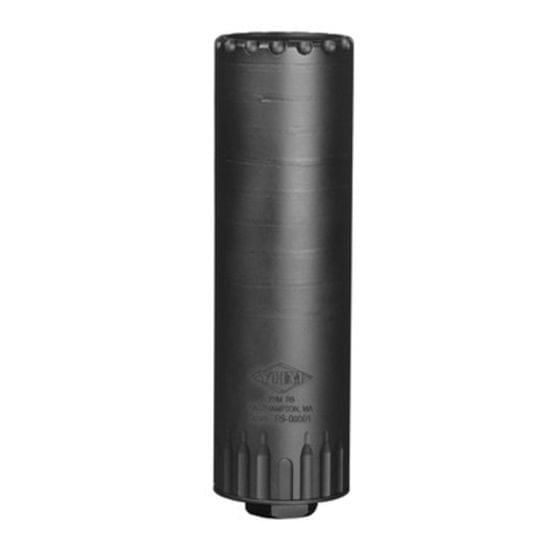
Yankee Hill Machine (YHM) R9
Primary Arms (See Price)
BattleHawk Armory (See Price)
Classic Firearms (See Price)
The YHM R9 is not the only suppressor to claim its budget-friendliness, but this can actually earns that title without making you feel like you’ve compromised on quality or performance. Designed by Yankee Hill Machine, a family-run shop out of Massachusetts with nearly 70 years of experience, the R9 doesn’t rest on the laurels of its modest price tag. It earns respect the old-fashioned way: with a battle-ready build and cross-platform performance.
Originally conceived for 9mm and subsonic .300 Blackout, the R9’s stainless-steel construction also makes it compatible with a broad range of calibers including 5.56 NATO, .308 Win, 7.62×39, and even .350 Legend. And yes, it’s full-auto rated. You won’t often find that combo for $500 to $600.
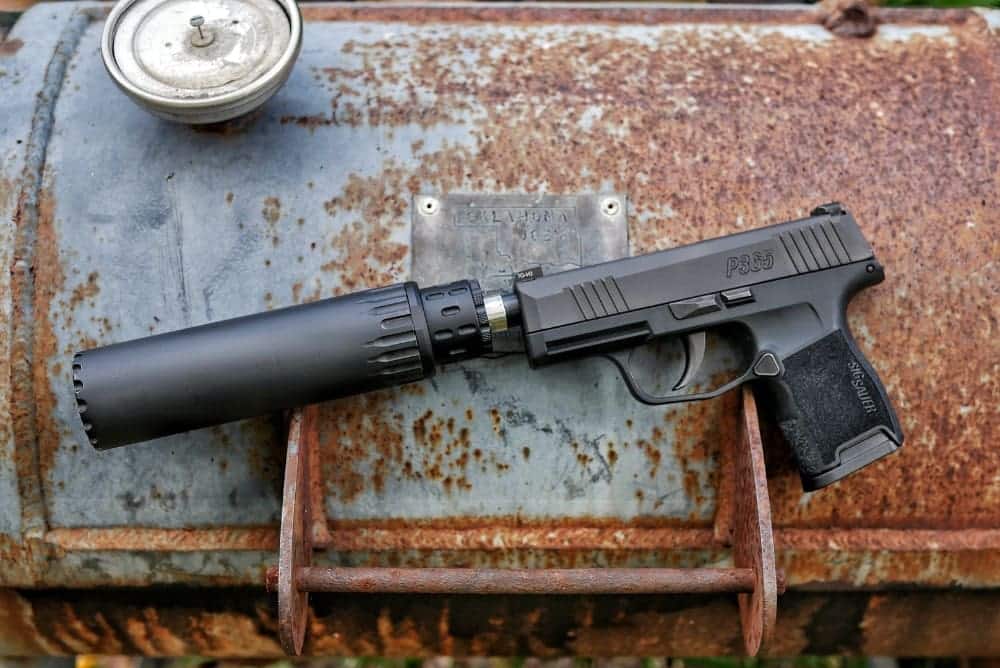
What We Like: The R9 is a value play that doesn’t feel cheap. It is a short, tubeless, fully welded can with a tone that belies its size. It uses the common HUB rear pattern, so you can go direct thread on a pistol today, then a 3‑lug or QD mount on a subgun tomorrow without buying a new suppressor.
The R9 is tough, adaptable, and works with multiple mounting systems including direct thread, 3-lug, and the YHM Phantom QD (Quick Detach) system.
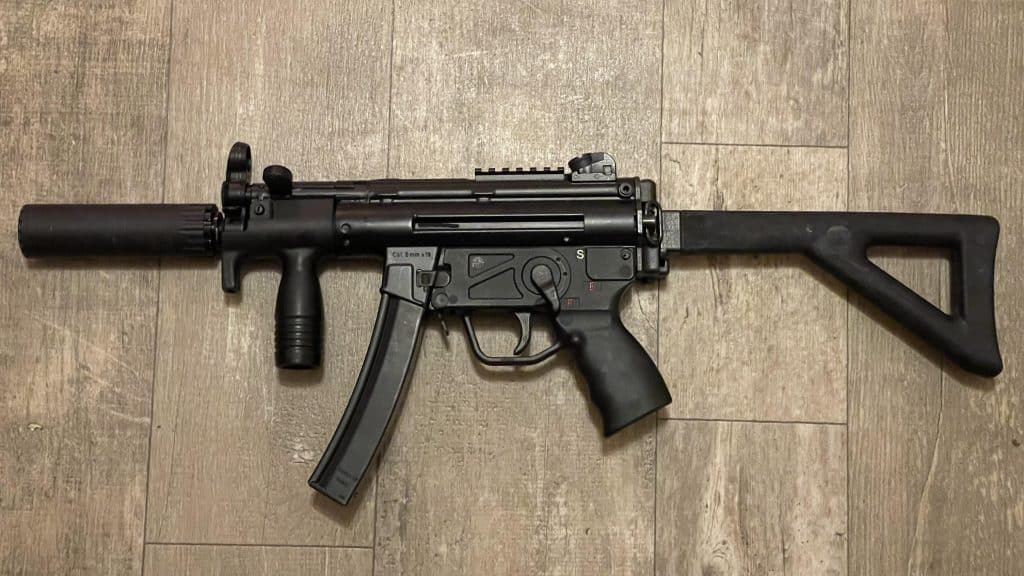
On a 9mm carbine, the action noise starts to overtake the muzzle report, which is exactly what you want. The small footprint helps pistols keep their balance, and on a blowback PCC the R9 stays stout when you run long strings. Its 17-4 stainless-steel body shrugs off heat and abuse like it’s daring you to break it.
It’s also surprisingly short and light for a suppressor this rugged: just 5.2” long and weighing in at 10.7 oz, making it a logical choice for home defense due to the increased maneuverability.
And did we mention that it’s usually available between $500 and $600? Yes, we did but it’s noteworthy enough to mention it again.
Flaws but Not Dealbreakers: This isn’t a modular suppressor and it’s not user-serviceable. It is sealed, so you are not pulling baffles for a scrub. That is fine for jacketed centerfire use, but this is not your heavy rimfire can.
If you’re looking for something that can be shortened or disassembled for cleaning, the R9 isn’t it. That said, it’s pretty short already, and there’s a subset of shooters (present party included) who appreciate a low-maintenance can. Consider it a tradeoff for the impressive price tag.
Trending: Best AR-15 Suppressors, Best AR-15s, Best 9MM Carbines
First‑round pop is a touch sharper than larger cans and you can feel a bit more ejection‑port grit on some blowback hosts.
Also, while it performs admirably for the price, don’t expect it to out-suppress a much more expensive can. It’s a budget pick, but quite a solid one.
Bottom Line: The R9 is for shooters who don’t want to, or can’t, spend much right out of the gate, or for those who simply want a straightforward, low‑maintenance suppressor. It delivers durability and versatility far above its price tag. If you’d rather shoot than scrub baffles, this little tank makes a ton of sense.
4. BEST FOR HOME DEFENSE: Dead Air Mojave 9
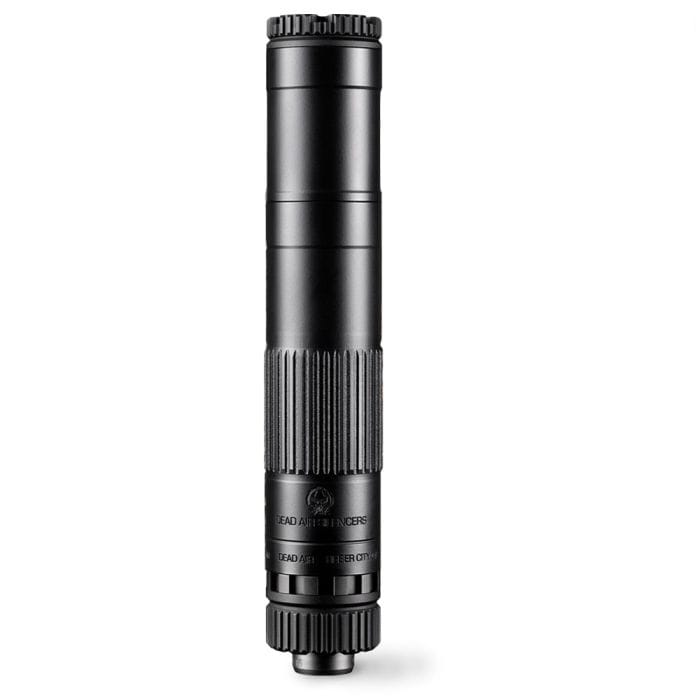
Dead Air Mojave 9
GrabAGun (See Price)
Euro Optic (See Price)
Bereli (See Price)
Guns.com (See Price)
Brownells (See Price)
BattleHawk Armory (See Price)
Classic Firearms (See Price)
Rainier Arms (See Price)
Piece of Mind (See Price)
KYGUNCO (See Price)
The Dead Air Mojave 9 blends cutting-edge materials with purpose-driven engineering to create a suppressor that’s as comfortable to shoot indoors as it is tough enough for hard use. It’s built for shooters who want confidence in close quarters and the peace of mind that comes from knowing their can can handle years of abuse.
At its core is a hybrid construction: a stainless-steel mount and blast chamber paired with a 3D-printed titanium baffle stack. This combination delivers the strength to shrug off heat, the precision to manage gas flow, and the weight savings to keep your firearm quick and responsive.
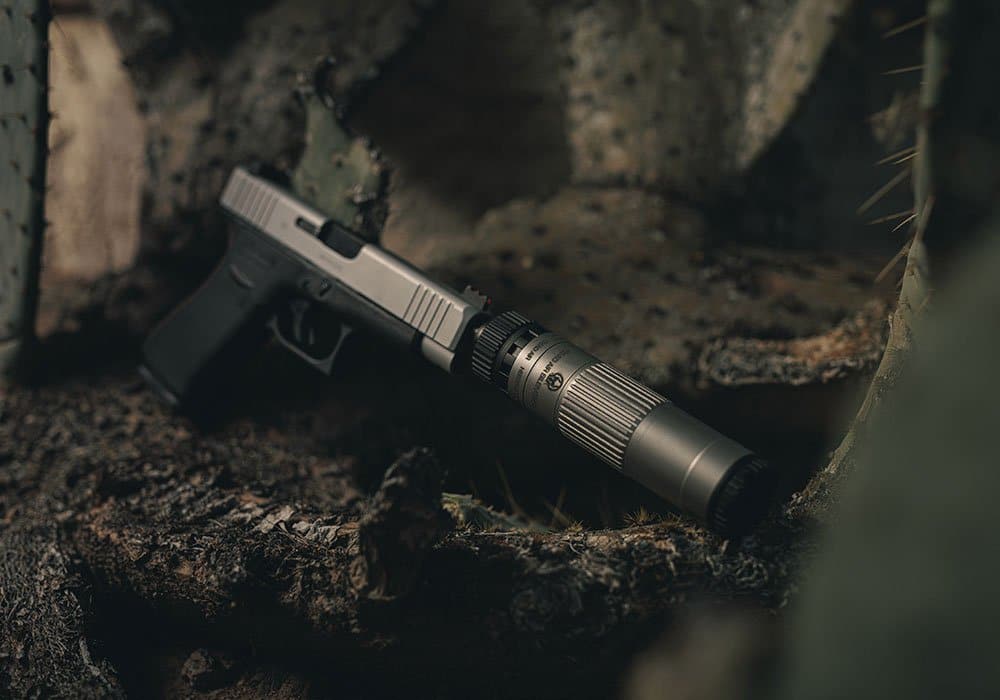
What We Like: The Mojave 9’s 3D-printed titanium internals are designed to push gas forward. That means less face-blast in hallways and shoot houses, and far less of that “eyes watering after two rounds” feeling.
Its low weight keeps a bedside pistol or braced PDW quick to mount and steady on target, and its smooth tone with mild first-round pop makes for a far less jarring shooting experience in confined spaces.
The Dead Air Mojave 9 leverages a hybrid construction, where 17-4 stainless steel is paired with a 3D-printed titanium baffle stack to fine-tune the internal components for strength, heat dispersion, and performance beyond that of traditional machining. The result? A suppressor that can eat heat and keep on running long after others quit.
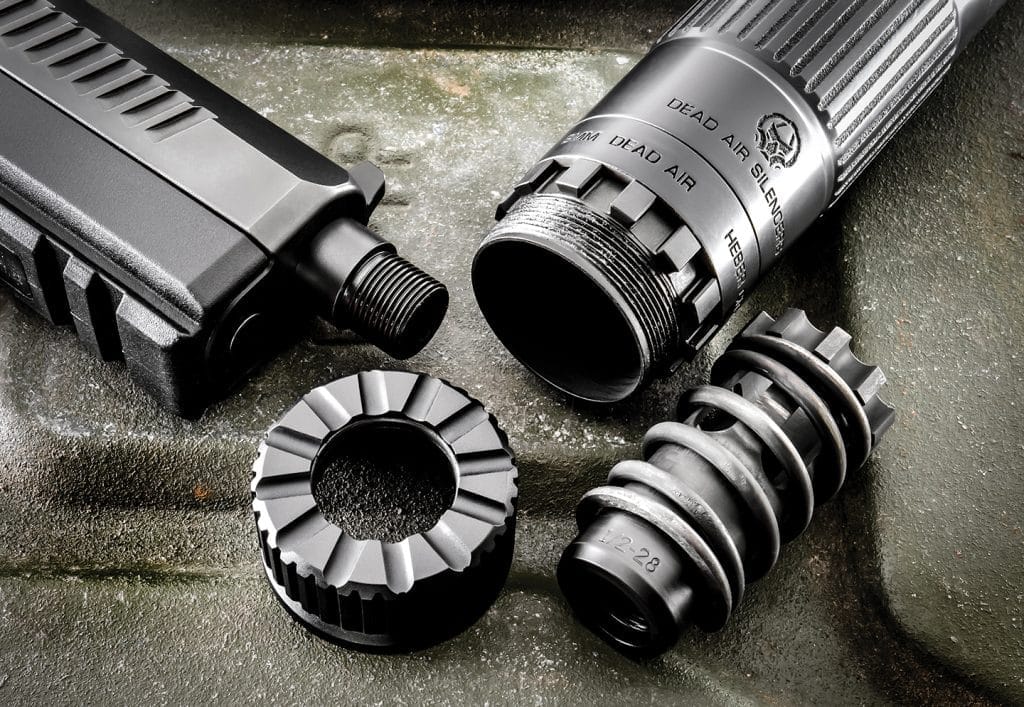
Length is modular. Run it long if you want maximum hush by the nightstand. Shorten it if you prefer a compact footprint around the house. The Mojave 9’s 3D-printed titanium core isn’t just strong; it’s designed with strategically curved and hollowed-out structures that fine-tune gas flow and thermal management. That means less blowback and longer life under sustained fire.
It’s full-auto rated, of course, and its modular design allows it to be configured in short or long mode (4.86” or 7.64”), giving you some flexibility with length and amount of suppression without sacrificing the tank-like construction. Despite that toughness, it only weighs around 9.6 oz in its short config and 12.8 oz in full-length.
We also like that the Mojave 9 supports multiple mounting systems including direct thread and Dead Air’s KeyMicro QD (Dead Air’s quick-detach system).
Flaws but Not Dealbreakers: With cutting-edge materials and manufacturing comes a higher price, as seen by the Mojave 9’s typical retail price of $1,000 to $1,100.
Beyond price, there’s little to nitpick with the Mojave 9, but some users may want a more modular or serviceable design. Since the baffle core is fully enclosed, cleaning is limited to soaking or using an ultrasonic cleaner. This isn’t an outright flaw, but If you’re someone who enjoys disassembling every part after a range trip, this can feel limiting.
Also worth noting: the uncoated titanium exterior is more prone to scratching and scuffing compared to suppressors with a Cerakote finish. If cosmetics matter, this is something to keep in mind.
On that note, titanium handles heat well for this role, but it is not the pick for back-to-back mag dumps. Also, the mounts live in Dead Air’s pistol ecosystem, which covers most users but is not the universal HUB route.
Bottom Line: If your priority is a suppressed pistol or PCC you can comfortably shoot indoors, the Mojave 9 is purpose‑built for that reality. It pairs advanced materials with thoughtful design to deliver exceptional suppression with minimal blowback. For high‑volume shooters or anyone who values cutting‑edge tech in a suppressor built to last a lifetime, and who’s comfortable paying a premium, the Mojave 9 is a superb fit.
5. MOST COMPACT 9MM SUPPRESOR: CGS Mod-9 SK
CGS Group’s Mod‑9 SK is the definition of small but mighty. This is the shorter “K” variant of their Mod‑9 suppressor, packing full‑size performance into a 4.8‑inch package. CGS is known for innovative baffle engineering, and the Mod‑9 SK showcases this with its second‑generation Orion baffles that maximize sound reduction despite the miniaturized size.
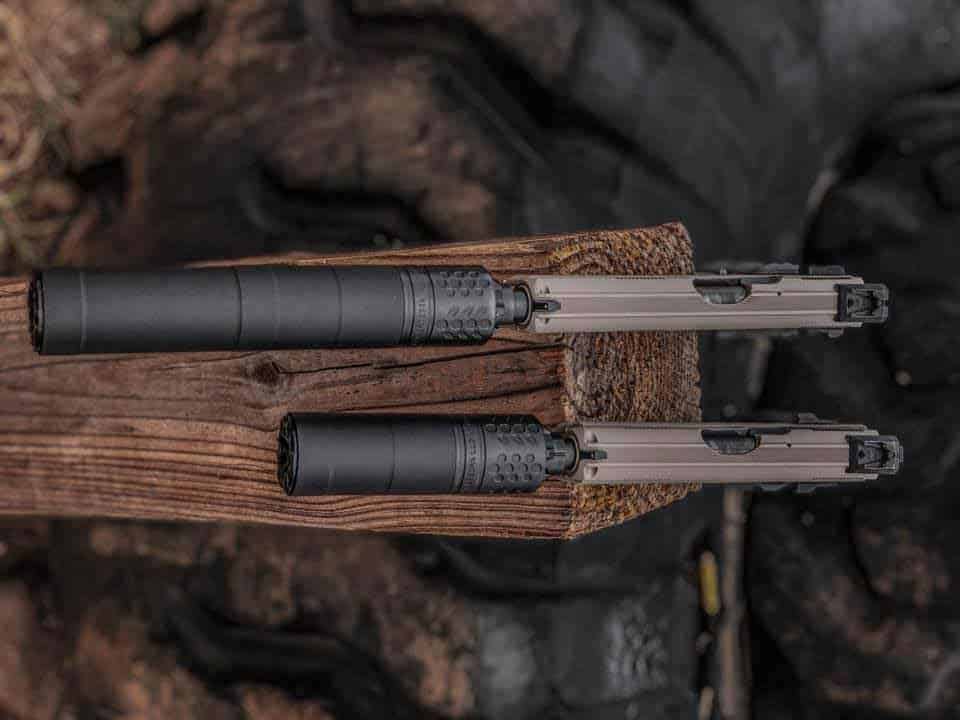
What We Like: This can is all about proportions. At just over 4.8 inches long and weighing in around 6.6 ounces, it keeps pistols lively and easy to bring on target, especially in tight quarters.
The reduced length means you’re not dragging the muzzle through doorways or over barricades, and your sight picture stays fast and uncluttered.
CGS uses a clever piston system with cuts that limit first‑round pop, so your first shot is nearly as quiet as the follow‑ups. Tone‑wise it’s impressively quiet for its size, especially with subsonic 147‑grain loads.
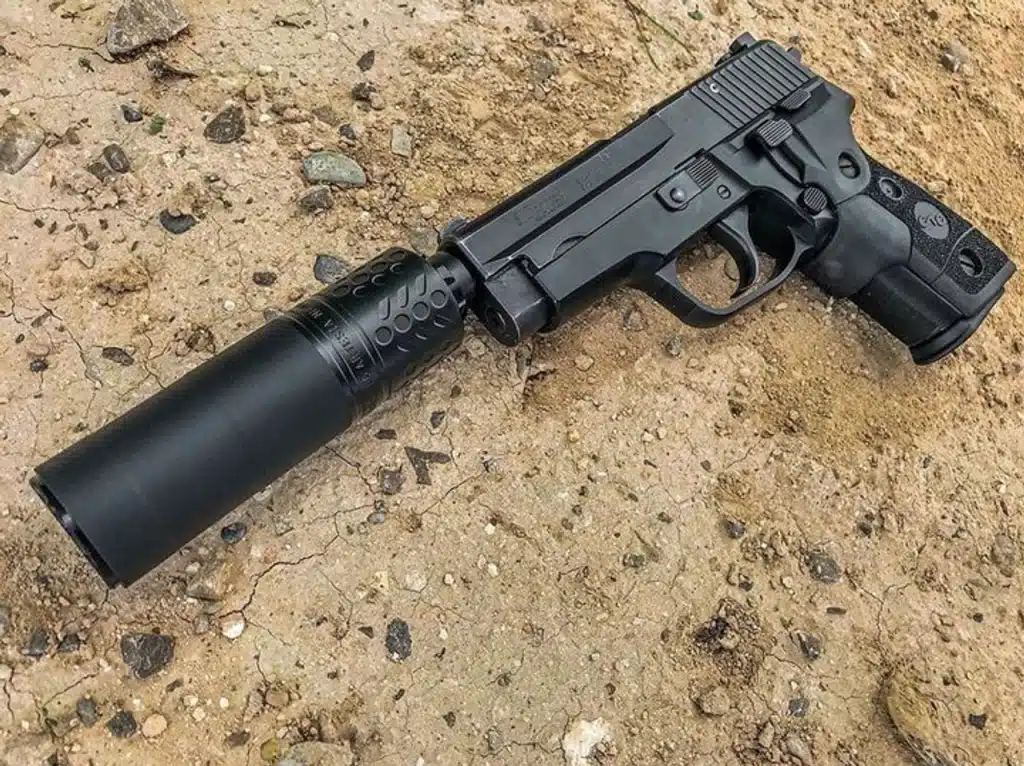
It’s constructed from lightweight 7075‑T6 aluminum with critical parts like the blast baffle and piston in 17‑4 stainless steel. Weighing only about six and a half ounces, it adds minimal heft to a handgun, making it as comfortable on a pistol as it is effective on a PCC.
We also like that the Mod‑9 SK is fully user‑serviceable: the inner sleeve protects the outer tube from carbon fouling and the baffles click back together without alignment tools.
Flaws but Not Dealbreakers: The trade‑off for this short package is reduced suppression compared to full‑length options. You’ll hear more first‑round pop and a slightly sharper report.
It’s also better suited for pistol hosts than blowback PCCs, where the extra volume of a longer can would help tame the bark.
Because it’s primarily aluminum, it’s not meant for sustained mag dumps or full‑auto abuse, and CGS doesn’t rate it for that kind of use.
Finally, removal can be a little fiddly if you twist the wrong section, so pay attention to where you grab it when unthreading it from the barrel.
Bottom Line: The Mod‑9 SK is built for shooters who value compactness and handling over absolute suppression. For concealed carry training, home defense, or anyone who simply dislikes the front‑heaviness of long cans, this is a smart, nimble option that still delivers solid performance.
6. BEST FOR FULL-AUTO: SilencerCo Omega 9K
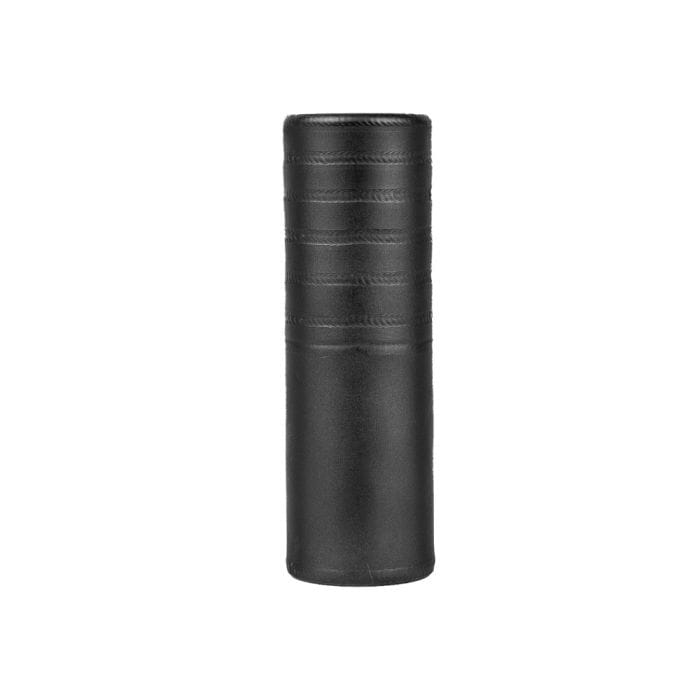
SilencerCo Omega 9K
Midway USA (See Price)
Guns.com (See Price)
Brownells (See Price)
GrabAGun (See Price)
KYGUNCO (See Price)
Classic Firearms (See Price)
AR15 Discounts (See Price)
If you want a can that keeps up when you run guns hard, the Omega 9K is the K‑length workhorse that actually earns the “full‑auto rated” line on the spec sheet.
SilencerCo has been the default answer for pistol cans for a long time, and the 9K is their short, fully welded option built to live on subguns and PCCs without turning your setup into a nose‑heavy club. It’s compact where it counts, tough where it needs to be, and happy on everything from an MP5 clone to a 9 mm AR to your duty pistol.
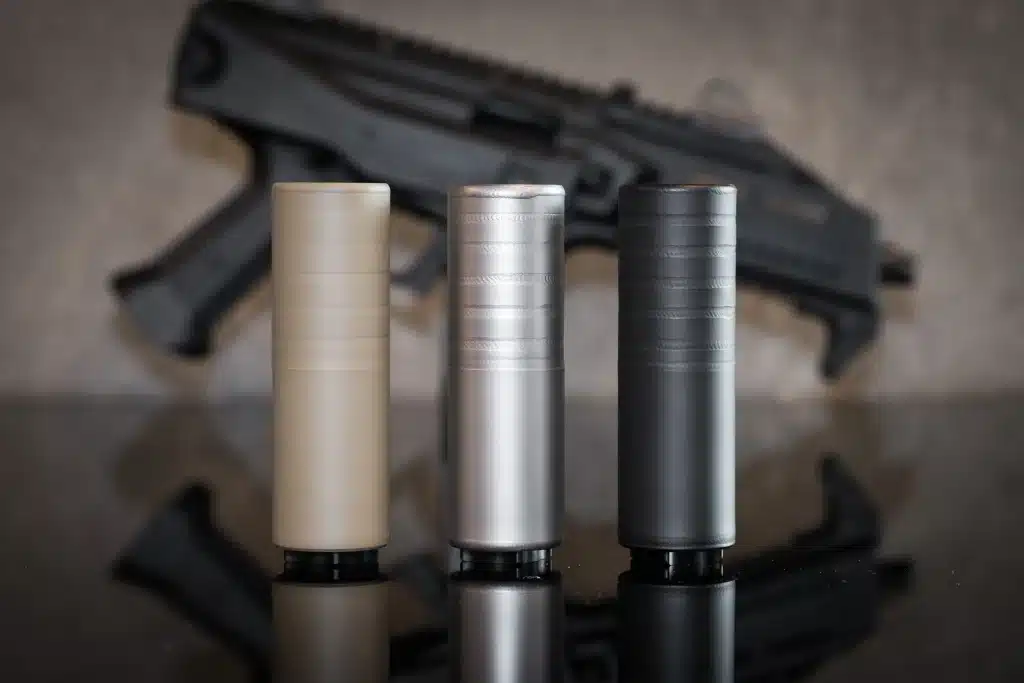
What We Like: For a can that’s only about 4.7 inches long and roughly 7 ounces, the Omega 9K sounds better than we expected. With 147–158‑grain subsonic 9 mm, you get a tight, low tone that makes the action noise the loudest part. On 115–124‑grain, the report is brighter but the blast is still tamed and perfectly workable outdoors.
The short body keeps swing weight down on pistols and makes a subgun feel quick between targets — you notice the lack of nose‑drag immediately.
Mounting is flexible and repeatable. It uses SilencerCo’s Alpha pattern, so you can run a piston for Browning‑tilt pistols, drop in a fixed‑barrel spacer for carbines, or go 3‑lug on MP5‑pattern guns. On true‑spec lugs the lockup is positive, and point‑of‑impact shift is small and consistent. Zero with the can on, jot the offset in your data book, and you won’t be chasing shots after routine on/off cycles.
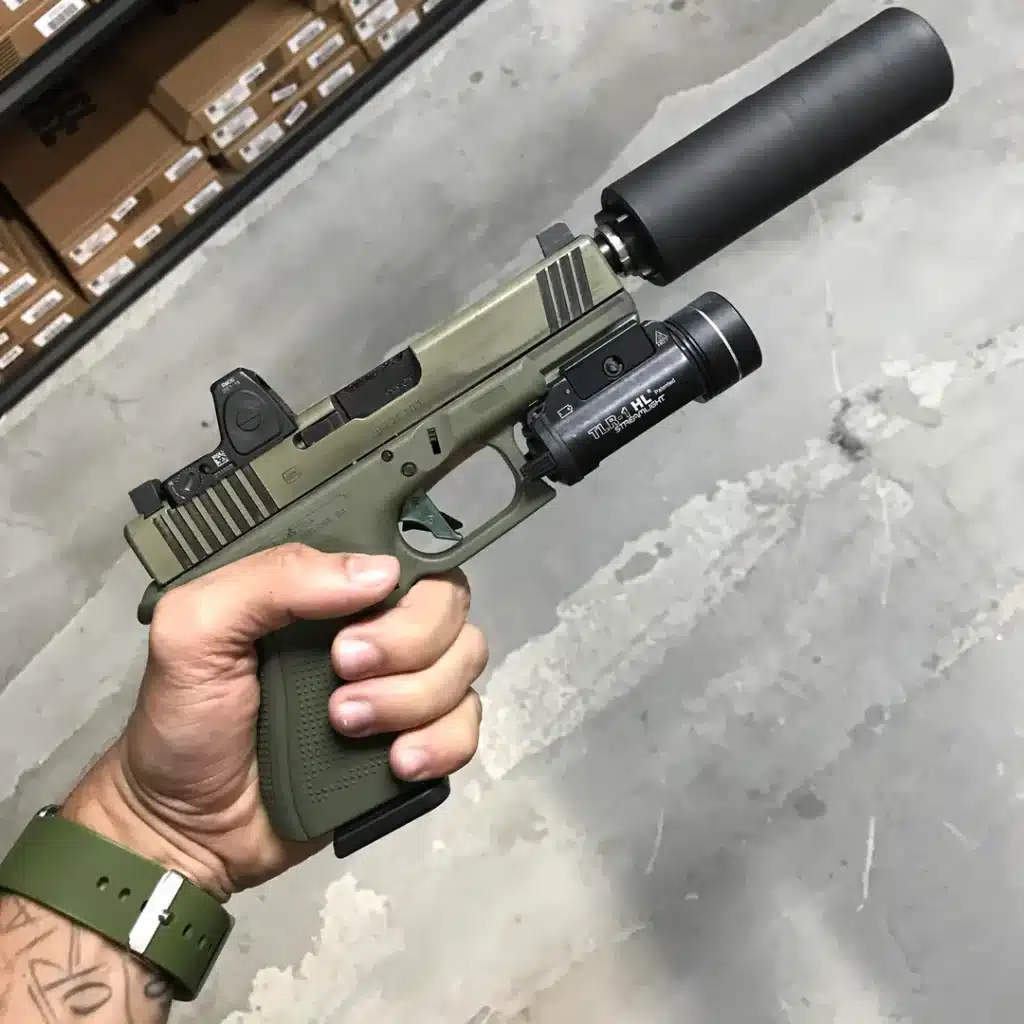
The fully welded stainless/cobalt core is built to take heat and doesn’t need babying. It shrugs off short, fast strings without wandering, resists carbon locking at the joints you actually touch, and keeps doing its job when cheaper tubes start to feel soft.
It’s also rated for subsonic .300 Blackout on appropriate hosts, which is a nice bonus if you want a single, small can that can play double duty in a pinch.
Flaws But Not Dealbreakers: Small volume is the trade‑off. It won’t be the quietest option in this lineup, and first‑round pop is a bit sharper compared to longer cans. On straight‑blowback PCCs you’ll hear more ejection‑port snap and may feel a touch more gas during long strings — a heavier buffer or tuned bolt helps if your build runs spicy.
It’s sealed and non‑modular by design. That’s part of why it’s tough and consistent under heat, but it also means no K/long conversion and no pulling baffles for a scrub. Maintenance is solvent soak or ultrasonic and rinse. If you want a can you can take apart, this isn’t it.
Because it’s compact, it soaks heat quickly. Expect mirage sooner than with larger cans if you’re shooting off irons or a diopter. A thin wrap or short cool‑down windows between drills keeps the view clean and the finish happier.
Bottom Line: The Omega 9K is the “short, tough, and ready” answer for full‑auto subguns and hard‑run PCCs that won’t wreck your handling on pistols. If you need a compact can that locks up solid on 3‑lug, takes real heat without wandering, and still delivers a civilized tone with subs, this is the right tool. It’s not the quietest, it’s not modular, but it is exactly what you want when the priority is durability, repeatability, and speed.
7. EASIEST TO MAINTAIN: Dead Air Wolfman
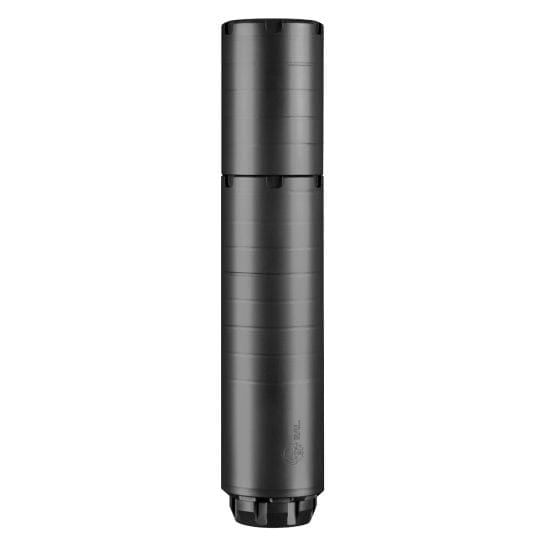
Dead Air Wolfman
Midway USA (See Price)
Bereli (See Price)
Primary Arms (See Price)
BattleHawk Armory (See Price)
KYGUNCO (See Price)
Classic Firearms (See Price)
For a cross-section of shooters, cleaning and maintenance are afterthoughts or at least are heavily procrastinated. Enter the Dead Air Wolfman, a suppressor you literally can’t take apart even if you want to. With a design that prioritizes simplicity and durability, the Dead Air Wolfman is truly a “canned” can in that no access is provided to its internal parts.
Dead Air took their popular Wolf‑9SD and refined it for modern needs, adding more mounting options and improving durability. The fully welded stainless‑steel core inside an outer tube means there are no delicate parts to lose or baffle stacks to reorder. If you’ve ever spent a Sunday scrubbing components, the Wolfman feels like a breath of fresh solvent.
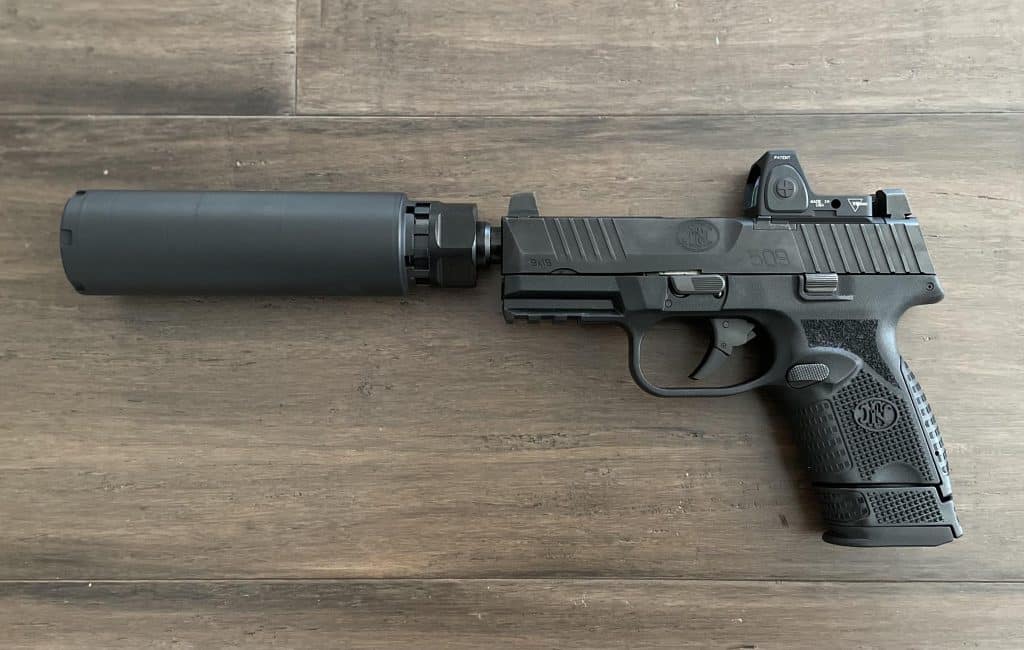
What We Like: If you run fast, this is the can that keeps up. The Wolfman’s fully welded core and larger diameter soak heat and flow gas in a way that stays friendly to actions.
In long mode the tone is deep and calm on MP5s, Scorpions, and AR‑9s, where the loudest thing you hear becomes the action cycling and the bullet’s thud. In short mode it trims to a handy package for pistols without becoming harsh.
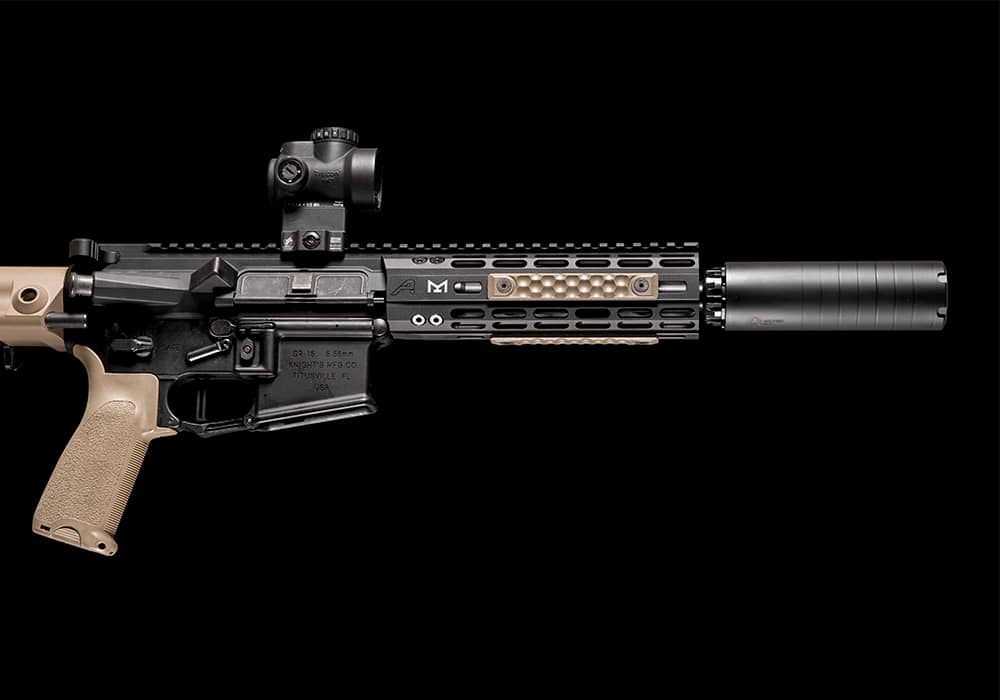
The Wolfman is made from 17-4 stainless steel, which is highly resistant to heat and corrosion. But what makes it truly easy to maintain is that there are no internal baffles to clean individually. The core is welded into a single structure, which you simply soak or scrub as a unit.
The modular outer tube unscrews into short (5.13″) and long (7.5″) configurations, letting you choose your balance of suppression and size.
Lastly, mount support is excellent: direct thread, 3‑lug, or Dead Air’s KeyMicro QD. If you need a can that shrugs off mag dumps and full‑auto fire, this is it.
Flaws but Not Dealbreakers: Because the core is fully welded, you won’t be pulling it apart to wipe down each piece individually. This is intentional. The design trades granular access for deliberate simplicity. A pass through an ultrasonic or a quick soak in a solvent handles most carbon buildup.
At about 14.4 ounces it’s heavier than the other options here, and on compact pistols you’ll notice the nose. Standard sights may disappear behind the tube, so plan on running a dot or taller irons. It’s a big can designed for big jobs.
Bottom Line: The Wolfman is for shooters who want to spend more time shooting and less time scrubbing baffles. Its monolithic core makes upkeep simple, and the modular tube adds versatility without adding complexity. If you’re running full‑auto or sustained fire on subguns and PCCs, this is the can that keeps up.
8. QUIETEST 9MM SUPPRESOR: Q Erector 9
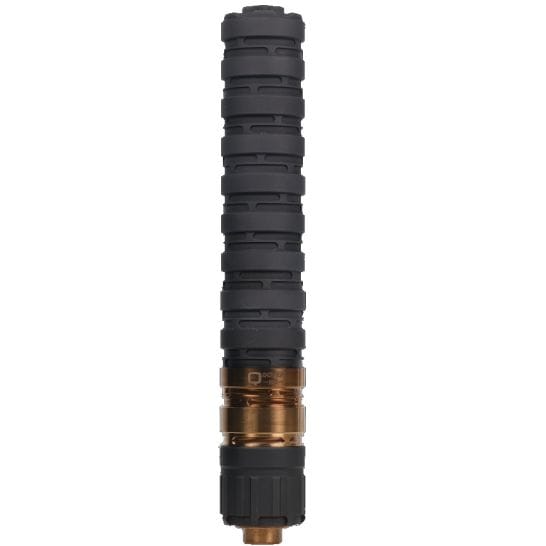
Q Erector 9
Bereli (See Price)
Euro Optic (See Price)
BattleHawk Armory (See Price)
KYGUNCO (See Price)
Rainier Arms (See Price)
Piece of Mind (See Price)
Classic Firearms (See Price)
Q’s Erector 9—often stylized as “ERECT9R”—is a suppressor like no other, embodying Q’s iconoclastic approach to silencer design. The team behind Q made waves with the .22 LR Erector, and with the Erector 9 they’ve applied the same philosophy to the pistol‑caliber world: ultimate modularity and minimal weight.
At first glance, the Erector 9 looks more like a Lego set than a traditional suppressor. It’s composed of ten interlocking baffle modules, one stainless‑steel blast baffle and nine aluminum baffles, plus an endcap. This design lets you assemble the suppressor in anywhere from a one‑baffle micro configuration all the way up to the full‑length ten‑baffle configuration, and any number in between.
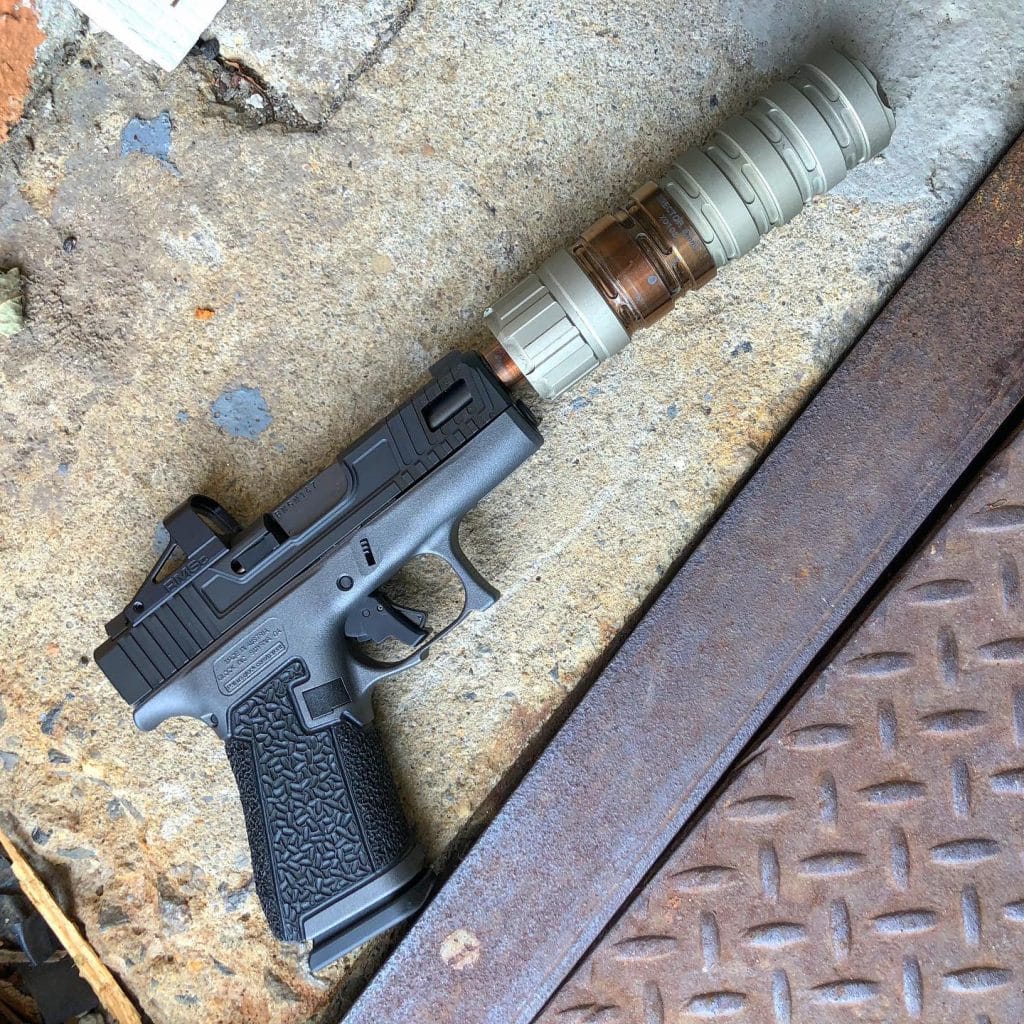
What We Like: The obvious headline feature of the Erector 9 is its modular baffle design. You can have it all: the quietest 9 mm suppressor possible and the smallest 9 mm suppressor possible, in one package. Most modular suppressors give you two lengths; the Erector gives you ten.
Need maximum suppression for ear‑safe hunting or backyard plinking? Screw on all nine baffles plus the blast baffle and enjoy remarkably quiet shots. Want the shortest setup for a nightstand pistol or to keep your carbine ultra‑handy? Run just a few baffles.
Dropping one or two baffles from full length only increases sound by a barely perceptible amount, so you can often remove two or three baffles, saving a couple of inches and an ounce or two, without sacrificing much suppression.
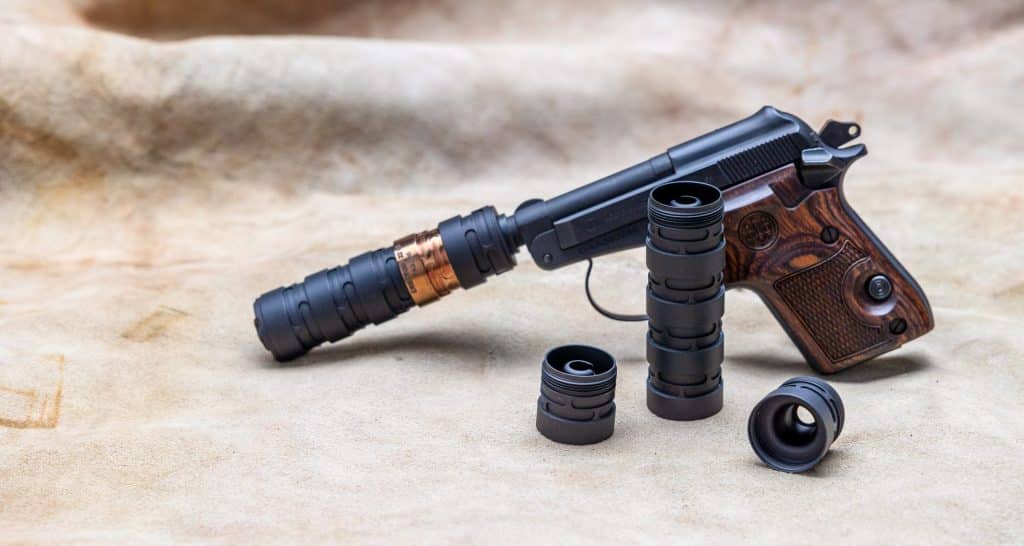
Each baffle module weighs a scant third of an ounce, and the blast baffle and mount keep most of the weight near the muzzle. That means even fully assembled the Erector balances nicely; in shorter configurations it’s almost unnoticeable out front.
In its longest form, the Erector 9 is about 8.7 inches long and weighs just over eight ounces—making it the lightest full‑size 9 mm suppressor on the market. Strip it down to the bare minimum and it’s a super stumpy unit around two inches long and a mere five ounces. Maximum tinkerability (not sure if I just made up a word or not) and control over length, tone, and balance.
Beyond its configurability, the Erector 9 delivers outstanding suppression in full form. The combination of a larger‑than‑average diameter, the stack of ten baffles, and Q’s baffle design yields a deep, soft tone that competes with or beats much heavier high‑performance cans.
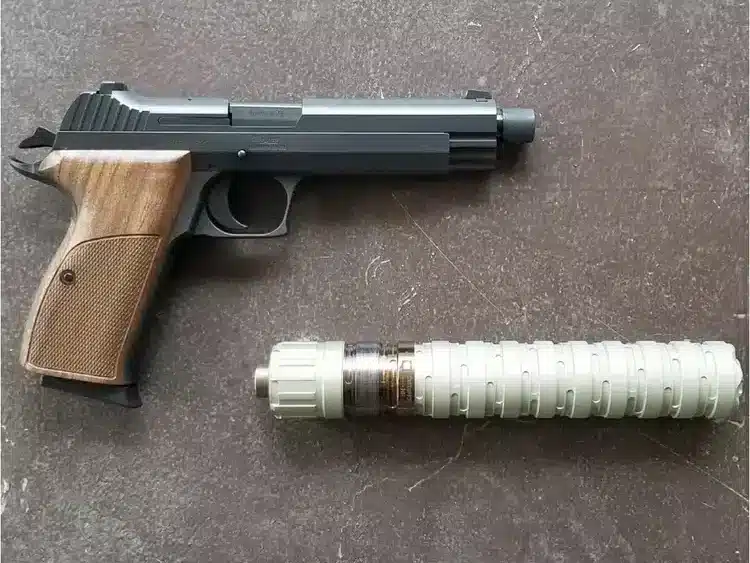
In practical use, most shooters will find a sweet spot in the middle—four to six baffles—where the tone and suppression are excellent while the can remains several inches shorter than full length.
We also appreciate that the Erector tends to exhibit low backpressure, especially in shorter configurations, which makes it comfortable to shoot and easy on your gun. The engineering is impressive: the baffles are beautifully machined, thread together smoothly, and the tubeless design eliminates excess material. It looks cool, too, with its two‑tone anodizing and bronze blast baffle.
Flaws but Not Dealbreakers: With its focus on weight savings, the Erector 9 is not built for sustained abuse or high‑pressure cartridges. It’s rated for 9 mm and smaller calibers only, and only for standard pistol or subsonic velocities—no supersonic rifle rounds here.
The aluminum baffles won’t withstand extreme heat or erosion like a Stellite or Inconel baffle would. Full‑auto or mag‑dump firing schedules are not advised.
There’s also more work for the owner: you have more pieces to keep track of, and the aluminum threads can gall if you don’t lubricate them during assembly. Cleaning aluminum baffles requires gentler solvents, and you’ll be cleaning ten individual baffles instead of one stack.
And yes, the Erector 9 is expensive ($900ish) so it’s a premium purchase for what is ultimately a niche suppressor. It’s also limited to pistol calibers; if you need a multi‑caliber workhorse, look elsewhere.
Finally, the Erector’s assembly process is more involved than a one‑piece can. You’ll want to take your time threading everything together properly. It’s not difficult, but it does require patience.
Bottom Line: The Q Erector 9 is one of the most innovative and versatile suppressors on the market, delivering an experience you can tailor completely. Run it long and whisper‑quiet on the range, then convert it to a short, carry‑friendly configuration when compactness matters more than absolute suppression. It’s ideal for enthusiasts who love fine‑tuning their gear and value extreme lightness. Treat it like the precision instrument it is and it will reward you with unmatched flexibility.
FINAL THOUGHTS ON THE BEST 9MM SUPPRESSOR
There you have it. Our picks for the best 9mm suppressors you can buy today.
A good suppressor is like a good trigger — you don’t really notice it when it’s doing its job, but you’ll sure as hell notice when it’s not. The best ones melt into the shooting experience. They take the bite out of every shot, keep your focus on the sights, and let you run your gun without thinking about the noise.
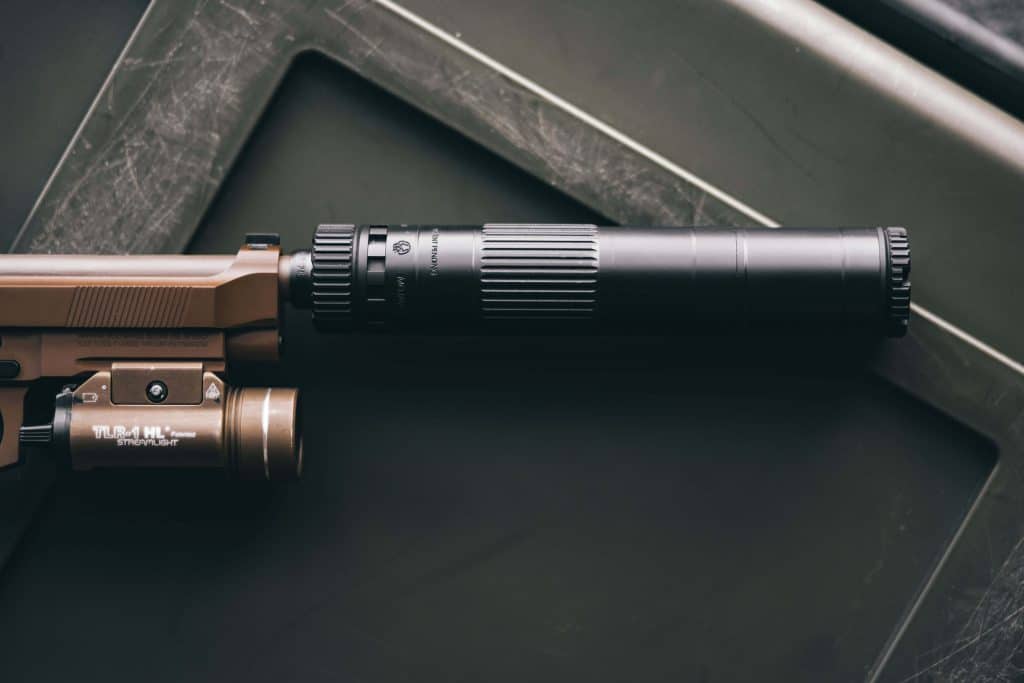
For all-around use, we recommend the Rugged Obsidian 9 as the do-everything workhorse. If budget is the deciding factor, the YHM R9 punches far above its price. If you run your guns hard, the Dead Air Wolfman will soak up the abuse.
For home defense, the Mojave 9’s gas-forward design is hard to beat. The CGS Mod-9 SK is the easy choice if compact handling is your top priority. And if you want the quietest, most tinker-friendly option out there, the Q Erector 9 is your playground.
At the end of the day, the right suppressor isn’t just a cool accessory, it’s a tool that changes how you shoot. It keeps you faster, steadier, and in control, and it makes the time behind the trigger that much better. So pick the one that matches how and what you shoot, get it mounted, and get back to doing what really matters: sending rounds downrange without the unnecessary noise.
Got a suppressor you swear by that didn’t make the list? Or maybe a horror story about one that failed you at the worst possible moment? Drop a comment below. Whether you back one of these picks or think there’s a better option out there, I want to hear what’s on the end of your barrel.

Justin Trump is the managing editor and owner of CAT Outdoors. The son of a Vietnam veteran, he’s a Certified Glock Armorer, an avid gun enthusiast and 2A advocate. He holds two firearm patents for the CAT M4 and Talon tools. When not managing CAT Outdoors, he enjoys spending time with his family and friends, rooting for Michigan sports teams, and serving his church.

